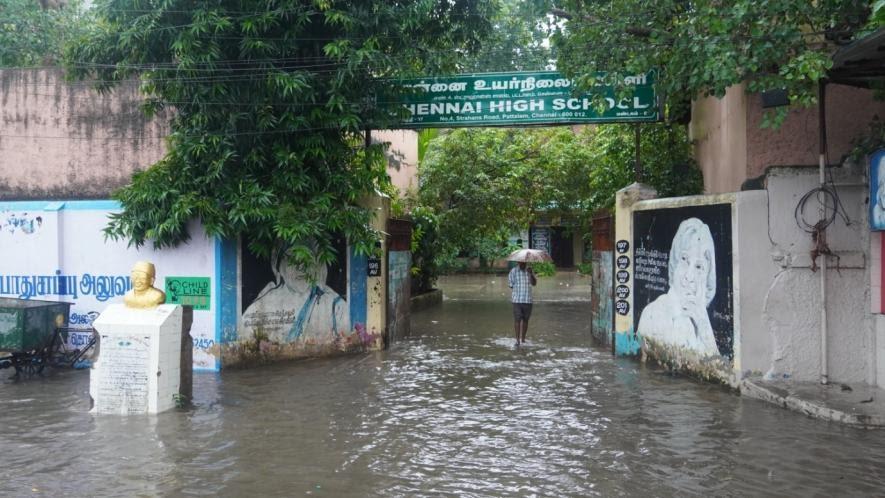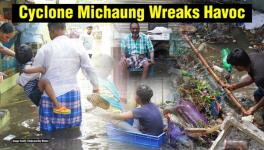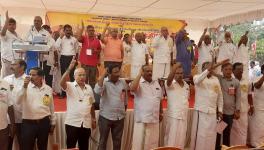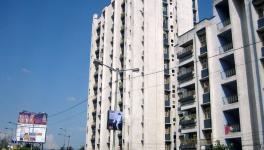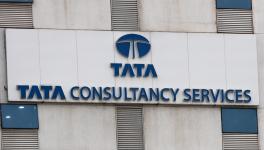TN Elections: Chennai ‘Smart City’, a Project for the Rich and Elite
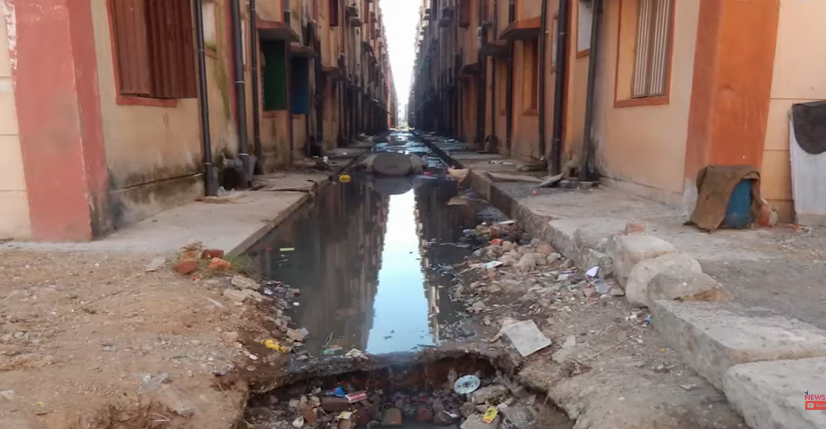
Improper drainage system in one of Chennai’s slum resettlement colonies
Chennai is the fourth largest urban agglomeration in the country and houses 22% of Tamil Nadu, but its geographic size is a meagre 4% of the state. As part of its industrialisation and urbanisation plans, in 2019, the AIADMK government proposed to expand the size of Chennai metropolis from 1,189 square km to 8,878 square km.
The state government published a draft notification of its plans to annex 1,710 villages in three districts -- Kancheepuram, Tiruvallur and Vellore -- as part of city expansion plans.
The decision met with opposition from different quarters, especially from farmers who did not want to give up their fields for city building. Environmental activists pointed out that it will do great damage to the ecology, with further encroachment of water bodies and marches.
KP Subramanian, an urban development expert, who filed a petition in the Madras High Court seeking to quash the notification argued that when the Chennai Metropolitan Development Authority (CMDA) is unable to perform its statutory duties within the existing area, it is highly impossible for it to perform its duties in the proposed seven-fold expansion.
This is a pertinent argument given that affordable housing, clean and accessible drinking water, and proper sanitation facilities are still a distant dream for many in Chennai. Encroachment of fishing villages, poor roads, sub-standard solid waste management, under-developed sewage treatment and limited electricity are some of the other concerns in the city.
REAL ESTATE BOOM AND LAND ENCROACHMENT
Paving the way for foreign direct investment (FDI), the government of India created the onset of a real estate boom in 2005. Beginning with the creation of the IT corridor, Chennai opened its doors to heavy investment, and within no time, this led to a real estate boom and hike in land prices.
Urban anthropologist Karen Coelho, faculty member in Madras Institute of Development Studies, whose site of study is Chennai, said: “We have allowed land prices to become absolutely unaffordable for the poor people. On the basis of land values, and speculative land values, land is being monetised. The government has not tried to check it, in fact the government has actually gained from it”.
She added “We have a mandate that for any large project, any project over one hectare, 10-15% for the land should be fixed for Economically Weaker Sections or the lower income group. That is never practiced. The CMDA lets people get away with it.”
Combined with the real estate boom, the demand for land for housing led to large-scale encroachment of water bodies within the city.
V Santhanam, who was the President of the Federation of the Residents’ Welfare Associations in Pallavaram municipality for four decades, said: “The dravidian parties gave away the water bodies and land for encroachment. This is purely vote bank politics. DMK and the AIADMK are sailing in the same boat. Neither the highways department, nor the municipality stopped this.” The Federation was formed to bring the issues of over hundred neighbourhoods under one body and jointly raise these with the authorities.
Claiming that despite the 2,000 plus petitions that he has filed on civic issues, nothing has been done, Santhanam said: “The government machinery is sluggish and full of corruption. I am 83 now, I continue to raise issues. In 2003, I was even attacked by goondas for exposing corruption” he said.
The percentage of encroachments of government properties in Chennai was 23.9 till 2019.
GHETTOISATION IN THE NAME OF SLUM CLEARANCE
The first Slum Clearance Board (TNSCB) in the country was established by Tamil Nadu in 1971. The board identified slums, and either built new, permanent homes or improved living conditions in slums.
Coelho said: “The models of housing used to be much more inclusive in the 1980s and 1990s, because it incorporated the poor into the cities”. It is when housing within the city became unaffordable for the lower income groups with the real estate boom, the idea of slum re-settlements came up. The only means to “implement a ‘housing for all’ approach was by relocating the poor outside city limits” she said.
This severed the slum dwellers from their means of livelihoods. These resettlement colonies are also not well integrated through transportation facilities. They also face tremendous water problems and poor sanitation.
Gunasekaran, a state Secretariat member of the Communist Party of India (Marxist), who writes on urban crises, told NewsClick that “though there are many housing schemes for the lower middle class, poor and those living in huts, the beneficiaries are low, it does not even cover 10% of the population”. He added that “many promises are made by the ruling class, but urban homelessness has gone up in the state, especially in the last 10 years”.
“Urban development has taken place on a contract and commission basis. Highways are on a rise, which target a certain elite class of people. On the other side, the number of huts is increasing by the day, marginalised sections are increasing in the cities, and development is not oriented towards them,” he added.
Sources from the Department of Economics and Statistics said that 4,667 housing plans were sanctioned for construction in 2015-16, all outsourced to the private sector. But, only 40% of the building construction was completed.
DIMINISHING WATER BODIES
Chennai, a city that suffers floods and droughts, continues to lose out on its water resources due to mismanaged urbanisation and encroachments. The systematic destruction of water bodies comes in the wake of the massive 2015 floods, and the yearly flooding of certain neighbourhoods followed by droughts in summer.
Santhanam stressed on clean drinking as a major problem in Chennai. “We have water bodies, Pallavaram had over half a dozen water bodies. Over time, these were destroyed and many disappeared. The municipality, which is responsible for water rejuvenation, is not doing their job. Despite having underground drainage systems (UGD) in place, sewage water is seeping into drains,” he said.
To meet the demand for water, and for clean drinking water, around two decades ago a tanker lorry culture began in Tamil Nadu. Balaraman, a leader of one of the welfare associations, said: “Drinking water issues persist year after year. With the onset of summer, in another 10 days, drinking water lorries will start coming in. Residents pay Rs. 1,500 for 10,000 litres, even though all the residents have piped water connections”.
In the last decade, to meet the need for clean drinking water, people began buying water cans and moving to water filters. Those who cannot afford such privileges, however, continue to drink poor quality tap water or water from common street taps and pumps.
“Though the government came up with some drinking water projects in the recent past, it has not ended the urban water crisis” said Gunasekaran.
TN TOPS THE ‘DIVISIVE’ SMART CITY PROJECT
Tamil Nadu has been sanctioned the maximum number of smart city projects and also tops the chart in completing the highest number of works under the Smart Cities Mission. Tamil Nadu has completed 414 works costing ₹1,168 crore.
Completely ignoring the dire issue of shortfall of houses and other basic needs, the Centre announced that it would build 100 smart cities and has allocated Rs 7,000 crore.
“The ruling classes are being selfish. They are not bothered about the majority. They are working on profit motive and corporate loot. The smart cities project is targeted at an elite middle class. In neighbourhoods like T Nagar in Chennai, roadside shops have been evacuated for expansion. Auto drivers have been greatly affected by this project.” said Gunasekaran.
Prof M. Vijayabaskar of the Madras Institute of Development Studies said “smart cities, the way these are designed and are being implemented is not equalising. They are trying to create something embedded in the larger framework... neoliberal framework, within which smart cities and infrastructure are planned”.
However, the culture of urban segregation began in Chennai much before the concept of ‘Smart Cities’ came up. By removing families living in slums and relocating them in the suburbs, “we have created more segregation in the aim to create world class cities which are aesthetically appealing” said Coelho.
Get the latest reports & analysis with people's perspective on Protests, movements & deep analytical videos, discussions of the current affairs in your Telegram app. Subscribe to NewsClick's Telegram channel & get Real-Time updates on stories, as they get published on our website.









